The Role of Cellulose Ether (HPMC) in Various Applications
Hydroxypropyl Methylcellulose (HPMC) is a cellulose ether that has garnered significant attention in various industrial and commercial applications due to its unique properties. Derived from natural cellulose through chemical modification, HPMC possesses excellent film-forming, emulsifying, and thickening abilities. These characteristics make it a valuable ingredient in a plethora of products ranging from pharmaceuticals and food to construction and personal care items.
Properties and Characteristics
HPMC is a non-ionic, water-soluble polymer. Its structure contains both hydrophobic and hydrophilic regions, allowing it to interact with both water and oil, which is crucial in formulating various products. One of its standout properties is its ability to form a gel in water at certain concentrations, which can help stabilize emulsions and suspensions. Additionally, HPMC exhibits a consistent viscosity profile, making it an ideal thickening agent in a variety of formulations.
Pharmaceutical Applications
In the pharmaceutical industry, HPMC is widely used as a binder in tablet formulations and as a controlled-release agent. Its ability to form a gel can help extend the release time of active pharmaceutical ingredients, providing sustained drug delivery. Moreover, HPMC is also utilized in hydrophilic matrix systems, which play a key role in moderating the release rates of drugs in the body. Its biocompatibility and low toxicity provide further advantages, making it a preferred choice for many pharmaceutical applications.
Food Industry Utilization
cellulosa esther (hpmc)

In the food sector, HPMC serves as a multifunctional additive. It is recognized for its ability to improve the texture and mouthfeel of various products. HPMC is commonly employed in gluten-free and low-fat formulations to enhance viscosity and provide the desired consistency in sauces, dressings, and ice creams. Additionally, it acts as a stabilizer in emulsions, such as mayonnaise or salad dressings, helping to maintain product quality and shelf life.
Construction and Building Materials
Beyond the realms of pharmaceuticals and food, HPMC is extensively used in construction materials. It is a principal ingredient in dry mortars, plaster, and tile adhesives, contributing to improved workability and adhesion properties. The inclusion of HPMC in these products aids in water retention, allowing for better drywall application and a more extended open time for manipulation. This results in enhanced durability and performance of construction materials, making HPMC indispensable in the building industry.
Personal Care Products
The cosmetic and personal care industries also leverage the beneficial properties of HPMC. It is a common ingredient in skincare products, shampoos, and conditioners, where its thickening and stabilizing abilities come into play. HPMC helps to create smooth formulations that enhance product application and sensory experience for the user. Moreover, its film-forming characteristics can help in creating protective barriers on the skin, which is particularly useful in lotions and creams.
Conclusion
The versatility of Hydroxypropyl Methylcellulose (HPMC) is evident across a vast array of industries. From pharmaceuticals to food, construction to personal care, its unique properties foster innovation and enhance product quality. As industries continue to evolve and demand higher performance materials, HPMC stands out as a reliable and effective solution. Its natural origins coupled with modern technological advancements pave the way for further exploration and application in various realms, ensuring its relevance for years to come. Whether enhancing drug formulations or improving food textures, HPMC remains a critical component in the development of cutting-edge products across sectors.
-
Rdp Powder: Key Considerations for Wholesalers in the Building Materials IndustryNewsJul.08,2025
-
Key Considerations for Wholesalers: Navigating the World of Hpmc - Based ProductsNewsJul.08,2025
-
Hpmc Detergent: Key Considerations for WholesalersNewsJul.08,2025
-
Key Considerations for Wholesalers: China Hpmc For Tile Adhesive, Coating Additives, Concrete Additives, and MoreNewsJul.08,2025
-
Crucial Considerations for Wholesalers: Navigating the World of Construction MaterialsNewsJul.08,2025
-
Key Considerations for Wholesalers Sourcing Additive For Cement, Additive For Concrete, Additive For Putty from Additive Manufacturer Shijiazhuang Gaocheng District Yongfeng Cellulose Co., Ltd.NewsJul.08,2025




